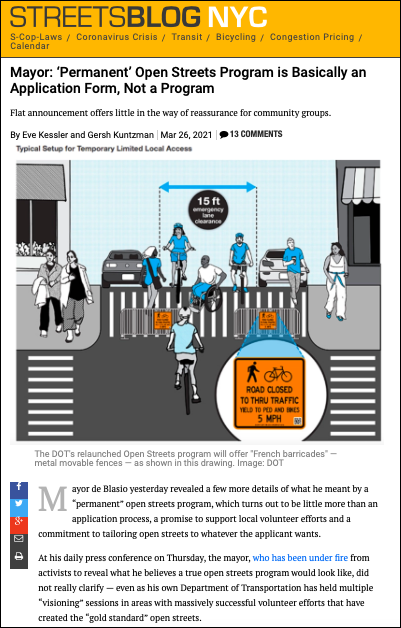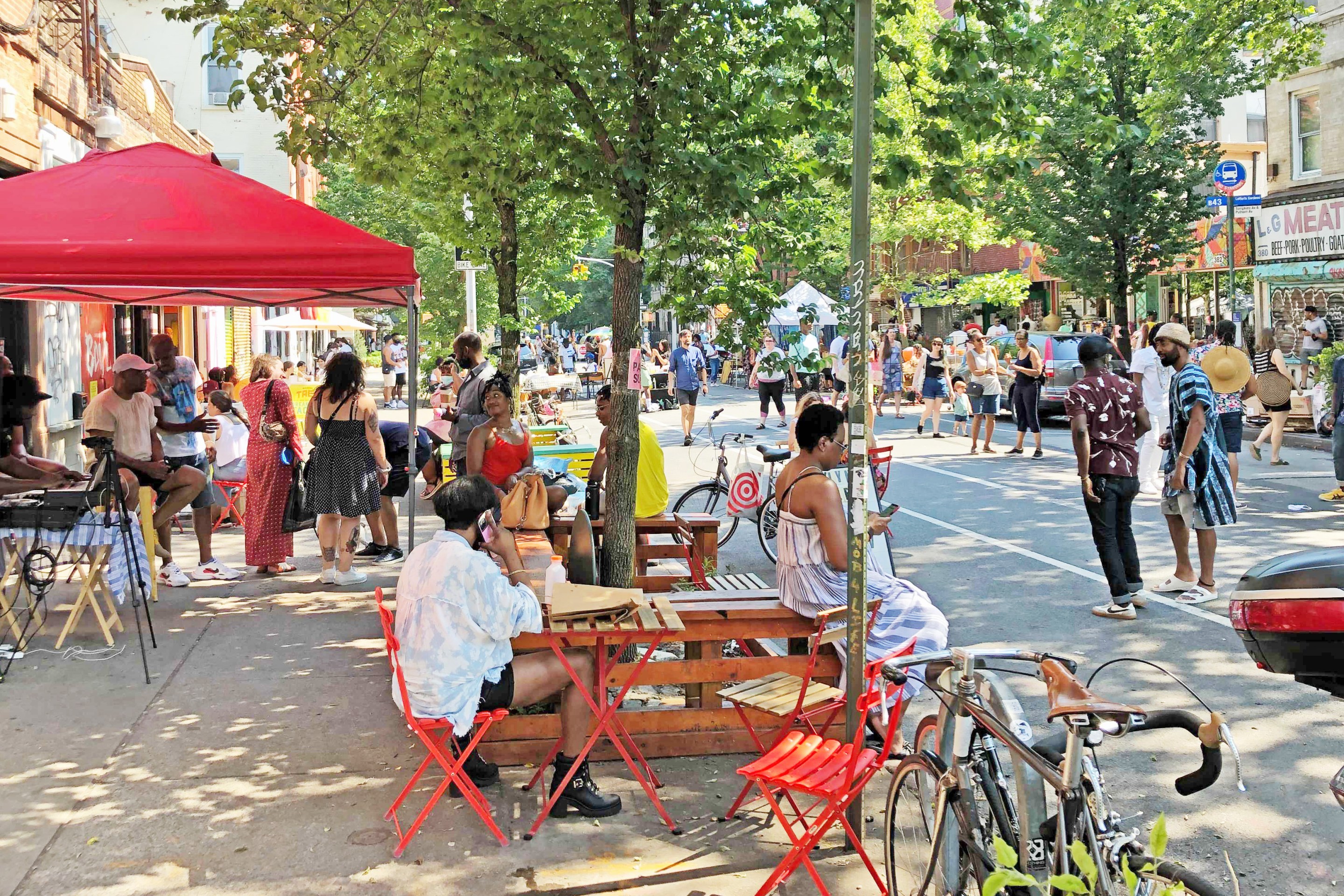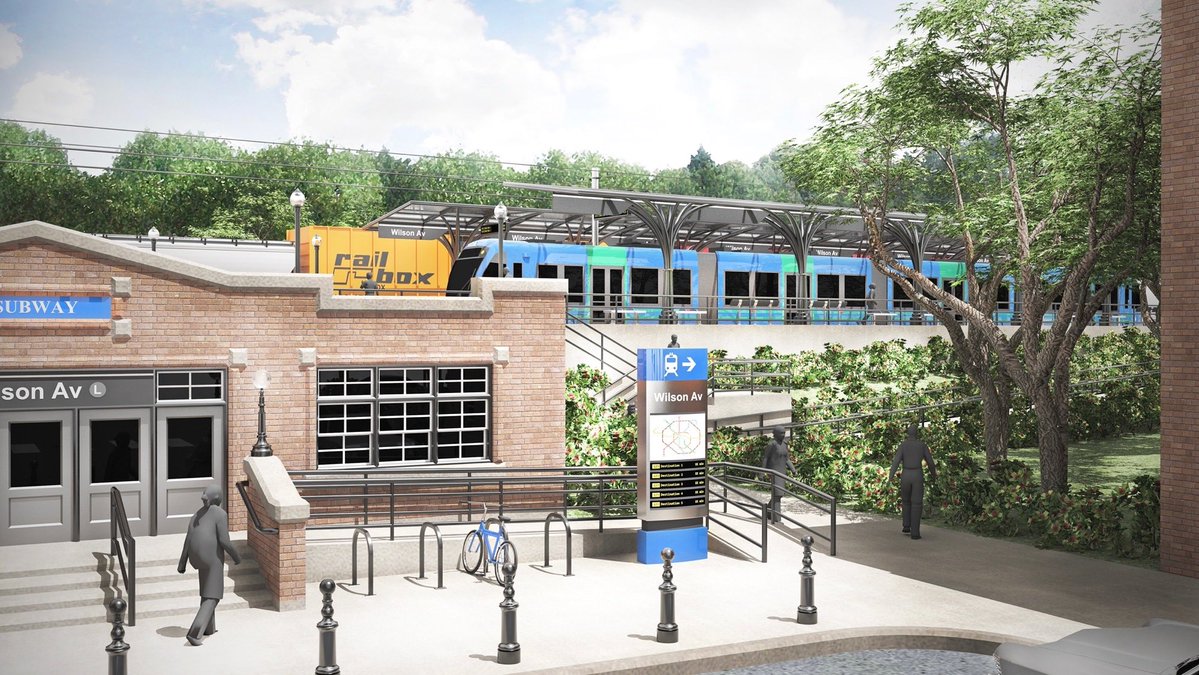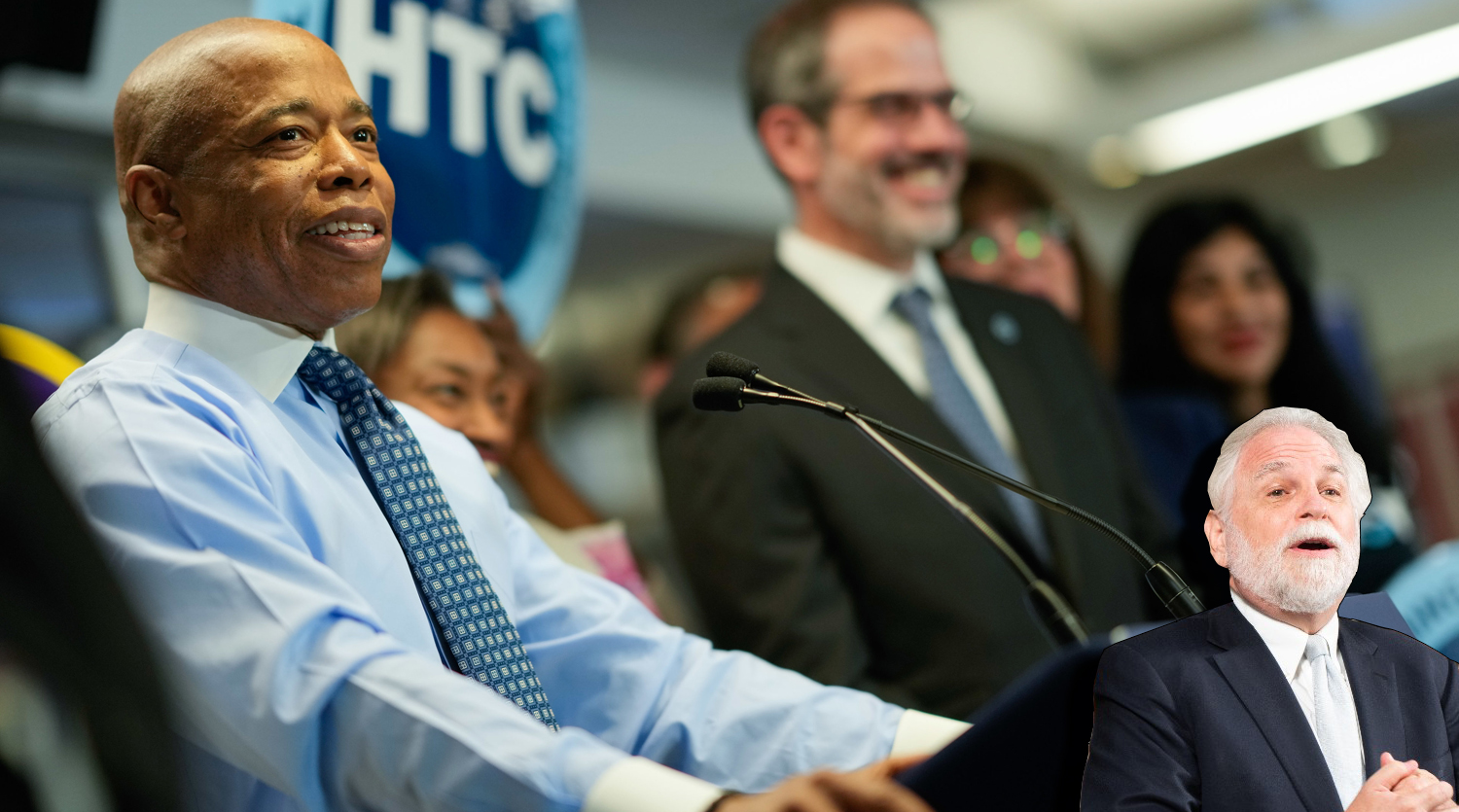ANALYSIS: The Massive Holes in de Blasio’s ‘Open Streets’ Announcement
12:01 AM EDT on March 30, 2021

Vanderbilt Avenue was one of the open street successes last year. It will return this year — again, thanks to a massive fundraising and volunteer effort. Photo: Prospect Heights Neighborhood Development Council
Go back to the drawing board.
Mayor de Blasio is under fire this week for his "confusing" and "underwhelming" announcement last week of a new application process for open streets — and some of the flak is coming from the very pols and local volunteers whose names were attached to the press release.
Most of the concern stems from the vague quality of the announcement itself, which invited volunteer organizations to apply on the city's website to create open streets (or re-apply, if the volunteer effort is already in place). The Department of Transportation will "work with community partners to develop operational plans," but the press release made it clear that community volunteers will still be entirely responsible for "managing street closure barricades," "coordinating operations and any programming" and "notifying local stakeholders and the community about" the open street.
The press release was under attack even before it dried — including from some people whose names are on it.
"Of course I was underwhelmed," Manhattan Borough President Gale Brewer told Streetsblog this week. "The announcement doesn't help people out, and it was confusing."
Just days earlier, Brewer had put her own report, "The Future of Open Streets," that demands a much more active city hand in designing roadways to be car-free and in programming the newly car-free spaces so that there is public acceptance of them.
"DOT could build on existing sites by transitioning them into the agency’s standardized redesign program," the report said. "This step would also help alleviate some of the open streets program issues pertaining to maintenance and barriers."
She called for major changes to the very map of the city, including making Pleasant Ave. between East 118th and 120th streets, a car-free permanent play street. Here's what that would look like:

"Open streets work when there are activities on them," said Brewer, who visited all of her borough's open streets during the pandemic. "When there were no activities, people would complain to me that the road shouldn't have been closed [to cars].
"But with the mayor — what's the overall program? What's the plan here?" Brewer added. "Someone in city government needs to make this happen. The best open streets are exciting places to be! Communities love them. But without people, you have dead streets. Who will bring in that programming?"
Brewer's report followed a similar slate of recommendations [PDF] put out by Transportation Alternatives in July, when the first major assessment of open streets was taking place. At the time, the group offered recommendations that would make open streets better, asking the city to:
- Make sure the open street segments are longer and connected.
- Reconfigure open streets as “transportation corridors by converting arterials which parallel subway lines into open streets.”
- Make the successful open streets — such as 34th Avenue in Jackson Heights — permanently car-free (as Streetsblog reported).
- Locate new open streets in areas with the least open space and the fewest transportation choices.
- Help community groups adopt open streets so the police would no longer need to manage the space.

City Hall spokesman Mitch Schwartz had thanked the group for its "feedback and creative thinking" and promised that the city was committed to"expanding the program and finding more ways than ever to use our urban landscape to emerge from this crisis a fairer, better city.”
None of the TA recommendations was included in the mayor's press release last week, something noted by the group's executive director, Danny Harris.
“We’ve long talked about the potential of open streets, especially amid the tremendous challenges of COVID," Harris said. "We outlined to Mayor de Blasio a vision and the steps needed for this potential to be realized. The Mayor deserves credit for announcing the program will be a permanent asset for New Yorkers, but he must also provide the necessary support and resources to the community groups that make this program come to life and a plan to build a larger, equitable network of open streets.”
For now, the best DOT Commissioner Hank Gutman could do is promise something soon.
"We are mindful of the fact that not all communities necessarily have readily available the resources to partner with us in this program," said Gutman, a former intellectual property lawyer and Democratic campaign donor appointed by the mayor in February. "We are planning to address that. So, again, don't let that deter you from applying. The instructions are online and we are working hard to make sure that no community, no neighborhood is left behind in this program."
But for those already in the program, the lack of support was noteworthy.
The 34th Avenue Coalition — whose volunteers have been setting up and taking down barriers since May, and have programmed the stretch between Junction Boulevard and 69th Street so well that the city calls it the "gold standard" of open streets — was quoted in the original press release in a way that avoided specifics. But hours later, one of the group's leaders tweeted his disappointment at the "red tape":
A key to our success on #34AveOpenStreets was not having to deal w/endless red tape, forms, applications etc. SO THEY ARE ADDING LAYERS OF RED TAPE?? We are unpaid VOLUNTEERS who raise money for signage, programming. Now we have to do EVEN MORE & reapply for the privilege? Why?
— JimRockaway (@JimRockaway) March 26, 2021
Queens Borough President Donovan Richards — who was also quoted positively in the mayor's press release — was quick to also point out the potential for red tape and eager to call for the mayor to go further than he did.
"To be clear, open streets have allowed us to rediscover our neighborhoods, and the fact that it's permanent is great," Richards told Streetsblog. "But we don't want this to be so volunteer-heavy. There have to be ways for the city to fund this and maybe even make it a youth job opportunity. Plus, on the design front, I've told the DOT that they need to think more boldly and through an equity lens. Does southeast Queens not deserve open streets too? I'm happy to put money into this program."
Gib Veconi, chair of the Prospect Heights Neighborhood Development Council, was similarly quoted in the press release talking about his neighborhood's massive volunteer effort. But in an interview with Streetsblog, he admitted that he had hoped for more support from City Hall. In the absence of support, his group actually had to go out and hire staff to ensure that the Vanderbilt Avenue restaurant street can be opened and closed for 33 weekends this summer, up from 16 last year.
"I don't want to minimize the challenge to the city — there are a lot of moving parts — but one thing that must be addressed by the city, as a matter of public policy, is that the implementation of this program has to be accessible and equitable to neighborhoods across the city, such as those without bids or non profits to jump into the fray," he said. "It can't be a barrier, if you don't have resources. That's the strongest argument for this being internalized by the city [not volunteers]. It is something that has to happen."
Veconi's volunteers and staffers will set up the popular restaurant street starting this Friday at 5 p.m. They'll make do with the equipment provided by the city for now.
"Eventually, there needs to be a design solution with some purpose-built equipment that is easier and faster to deploy than putting up 80 to 100 barriers, quickly, in an hour," he said. His group is working with the design firm Arup (another privilege few neighborhoods can afford), but believes the city "must make the program more sustainable."
Danny Dromm, the council member for Jackson Heights is certainly not sure of the entire program — and he was also underwhelmed by the mayor's announcement — but said he's fighting hard to make 34th Avenue a permanent, 24-7 car-free space.
"I have a verbal guarantee from the mayor that 34th Avenue will be a permanent open street, and we are in the process of deciding what the design will look like," Dromm told Streetsblog. "I expect the mayor will keep his commitment. I have not heard anything different."
Dromm admitted that no one knows — and the mayor is not saying — what "permanent" actually means. A roadway that is currently closed for cars between 8 a.m. and 8 p.m. might be turned into a open street that only operates between noon and 5 p.m. in the summer — albeit every summer.
"We don't know," Dromm said. "In some of the workshops, I have been surprised to hear DOT not being 100 percent consistent with what we have now, let alone closing it to cars 24-7 forever."
Dromm said there have been discussions about "permanent changes to the streetscape that would require capital dollars," and promised to provide such funding if asked.
But the DOT has not asked yet.
Update: At his Tuesday press conference, Mayor de Blasio did not clarify anything. Asked about Brewer's call for real design solutions, the mayor said this:
Open streets have been extraordinary. Yeah, there are logistics that have to go with it, but it's an idea that's really worked. And in the current form, it's offered a lot of opportunity for people to be outdoors and have a positive experience. but it also offers us some flexibility. But the future of this city is having as much open space as possible. Sometimes it will be done in a temporary way, sometimes it will be done in a permanent way. We should look at all of it. But what we do know is that a lot of changes are happening in the streetscape and that's for the good. Open streets have worked. Open restaurants have worked. More and more we will be using our space differently. This is a beginning. There's lots of potential going forward. We are looking at a lot of options. But I will not make news before it's time, but we are looking at a lot of options.
Gersh Kuntzman is editor in chief of Streetsblog NYC and Streetsblog USA. He also writes the Cycle of Rage column, which is archived here.
Read More:
Stay in touch
Sign up for our free newsletter
More from Streetsblog New York City
Gotcha-Heimer! Anti-Congestion Pricing Jersey Rep. With a City Speeding Ticket Drove to Manhattan on Wednesday
New Jersey's most vociferous opponent of congestion pricing parked illegally and once got a speeding ticket.
Under Threat of Federal Suit (Again!), City Hall Promises Action on ‘Unacceptable’ Illegal Police Parking
A deputy mayor made a flat-out promise to eliminate illegal police parking that violates the Americans With Disabilities Act. But when? How? We don't know.
Wednesday’s Headlines: Four for Fifth Edition
The good news? There's a new operator for the Fifth Avenue open street. The bad news? It's four blocks, down from 15 last year. Plus other news.
MTA Plan to Run Brooklyn-Queens Train on City Streets a ‘Grave’ Mistake: Advocates
A 515-foot tunnel beneath All Faiths Cemetery would slightly increase the cost of the project in exchange for "enormous" service benefits, a new report argues.
Full Court Press by Mayor for Congestion Pricing Foe Randy Mastro
Pay no attention to that lawyer behind the curtain fighting for New Jersey, the mayor's team said on Tuesday, channeling the Wizard of Oz.




